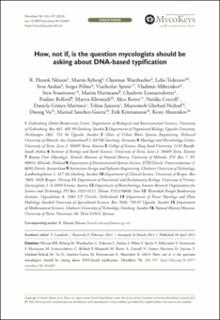| dc.contributor.author | Nilsson, R. Henrik | |
| dc.contributor.author | Ryberg, Martin | |
| dc.contributor.author | Wurzbacher, Christian | |
| dc.contributor.author | Tedersoo, Leho | |
| dc.contributor.author | Anslan, Sten | |
| dc.contributor.author | Põlme, Sergei | |
| dc.contributor.author | Spirin, Viacheslav | |
| dc.contributor.author | Mikryukov, Vladimir | |
| dc.contributor.author | Svantesson, Sten | |
| dc.contributor.author | Hartmann, Martin | |
| dc.contributor.author | Lennartsdotter, Charlotte | |
| dc.contributor.author | Belford, Pauline | |
| dc.contributor.author | Khomich, Maryia | |
| dc.contributor.author | Retter, Alice | |
| dc.contributor.author | Corcoll, Natàlia | |
| dc.contributor.author | Martinez, Daniela Gómez | |
| dc.contributor.author | Jansson, Tobias | |
| dc.contributor.author | Ghobad-Nejhad, Masoomeh | |
| dc.contributor.author | Vu, Duong | |
| dc.contributor.author | Sanchez-Garcia, Marisol | |
| dc.contributor.author | Kristiansson, Erik | |
| dc.contributor.author | Abarenkov, Kessy | |
| dc.date.accessioned | 2023-09-22T11:06:23Z | |
| dc.date.available | 2023-09-22T11:06:23Z | |
| dc.date.created | 2023-06-06T13:09:59Z | |
| dc.date.issued | 2023 | |
| dc.identifier.issn | 1314-4057 | |
| dc.identifier.uri | https://hdl.handle.net/11250/3091333 | |
| dc.description.abstract | Fungal metabarcoding of substrates such as soil, wood, and water is uncovering an unprecedented number of fungal species that do not seem to produce tangible morphological structures and that defy our best attempts at cultivation, thus falling outside the scope of the International Code of Nomenclature for algae, fungi, and plants. The present study uses the new, ninth release of the species hypotheses of the UNITE database to show that species discovery through environmental sequencing vastly outpaces traditional, Sanger sequencing-based efforts in a strongly increasing trend over the last five years. Our findings challenge the present stance of some in the mycological community – that the current situation is satisfactory and that no change is needed to “the code” – and suggest that we should be discussing not whether to allow DNA-based descriptions (typifications) of species and by extension higher ranks of fungi, but what the precise requirements for such DNA-based typifications should be. We submit a tentative list of such criteria for further discussion. The present authors hope for a revitalized and deepened discussion on DNA-based typification, because to us it seems harmful and counter-productive to intentionally deny the overwhelming majority of extant fungi a formal standing under the International Code of Nomenclature for algae, fungi, and plants. | en_US |
| dc.language.iso | eng | en_US |
| dc.publisher | Pensoft Publishers | en_US |
| dc.rights | Navngivelse 4.0 Internasjonal | * |
| dc.rights.uri | http://creativecommons.org/licenses/by/4.0/deed.no | * |
| dc.title | How, not if, is the question mycologists should be asking about DNA-based typification | en_US |
| dc.type | Journal article | en_US |
| dc.type | Peer reviewed | en_US |
| dc.description.version | publishedVersion | en_US |
| dc.rights.holder | Copyright 2023 The Author(s) | en_US |
| cristin.ispublished | true | |
| cristin.fulltext | original | |
| cristin.qualitycode | 1 | |
| dc.identifier.doi | 10.3897/mycokeys.96.102669 | |
| dc.identifier.cristin | 2152246 | |
| dc.source.journal | MycoKeys | en_US |
| dc.source.pagenumber | 143-157 | en_US |
| dc.identifier.citation | MycoKeys. 2023, 96, 143-157. | en_US |
| dc.source.volume | 96 | en_US |

